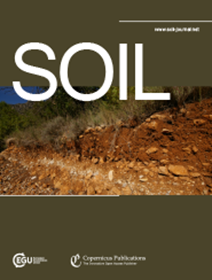An in-situ methodology to separate the contribution of soil water content and salinity to EMI-based soil electrical conductivity
IF 4.3
2区 农林科学
Q1 SOIL SCIENCE
引用次数: 0
Abstract
Abstract. Salt accumulation in the root zone limits agricultural productivity and can eventually lead to land abandonment. Therefore, monitoring the spatial distribution of soil water content and solution salinity is crucial for effective land and irrigation management. However, assessing soil water content and salinity at the field scale is often challenging due to the heterogeneity of soil properties. Electromagnetic induction (EMI) offers a fast, non-invasive, in situ geophysical method to map spatial variability in soil. EMI instruments measure the apparent soil electrical conductivity (ECa), which reflects the integrated contribution of the bulk electrical conductivity (σb) of different soil layers. By inverting the measured ECa, it is possible to obtain the distribution of the σb along the soil profile, which provides indirect information on soil salinity. However, in saline soils, σb is influenced by both water content (θ) and soil solution electrical conductivity (σw) (the salinity), making it difficult to independently quantify these two variables through a single, straightforward procedure. The objective of this study is to separate the respective contributions of θ and σw to σb, as obtained from the EMI inversion. To achieve this, ECa was measured using a CMD-MiniExplorer instrument in two maize plots irrigated with saline and non-saline water, respectively, in an agricultural field in southern Italy. The dataset was then inverted in order to obtain the σb distribution. By employing a site-specific calibrated Rhoades linear model and assuming homogeneity between the two plots, the spatial distribution of θ and σw in the saline plot was successfully estimated. To validate the results, independent measurements of soil water content by Time Domain Reflectometry (TDR) and direct measurement of soil solution electrical conductivity, σw, were performed. The proposed procedure enables the estimation of θ and σw with high accuracy along the soil profile, except in the soil surface, where EMI reliability is limited. These findings demonstrate that the integration of EMI with a site-specific θ - σb - σw model is a reliable and efficient in-situ approach for mapping soil salinity and water content at field scale, offering valuable insights for optimizing agricultural irrigation management in systems using saline water.一种分离土壤含水量和盐度对emi土壤电导率贡献的原位方法
摘要。根区盐的积累限制了农业生产力,最终可能导致土地荒废。因此,监测土壤含水量和溶液盐度的空间分布对有效的土地和灌溉管理至关重要。然而,由于土壤性质的异质性,在田间尺度上评估土壤含水量和盐度往往具有挑战性。电磁感应(EMI)提供了一种快速、非侵入性的原位地球物理方法来绘制土壤的空间变异性。土壤表观电导率(ECa)反映了不同土层体电导率(σb)的综合贡献。通过反演实测的ECa,可以得到σb在土壤剖面上的分布,从而提供土壤盐度的间接信息。然而,在盐渍土中,σb同时受到含水量(θ)和土壤溶液电导率(σw)(盐度)的影响,因此很难通过单一的、直接的程序来独立地量化这两个变量。本研究的目的是分离从电磁干扰反演中获得的θ和σw对σb的各自贡献。为了实现这一目标,在意大利南部的一块农田中分别用盐水和非盐水灌溉的两块玉米地块上,使用CMD-MiniExplorer仪器测量了ECa。然后对数据集进行倒转,得到σb分布。采用特定地点标定的Rhoades线性模型,假设两样地均匀性,成功估计了盐水样地θ和σw的空间分布。为了验证结果,采用时域反射法(TDR)独立测量了土壤含水量,并直接测量了土壤溶液电导率σw。所提出的方法能够沿土壤剖面高精度地估计θ和σw,除了土壤表面,那里的电磁干扰可靠性有限。这些结果表明,将电磁干扰与特定地点的θ - σb - σw模型相结合是一种可靠、有效的现场土壤盐度和含水量测量方法,为优化盐碱水系统的农业灌溉管理提供了有价值的见解。
本文章由计算机程序翻译,如有差异,请以英文原文为准。
求助全文
约1分钟内获得全文
求助全文
来源期刊

Soil
Agricultural and Biological Sciences-Soil Science
CiteScore
10.80
自引率
2.90%
发文量
44
审稿时长
30 weeks
期刊介绍:
SOIL is an international scientific journal dedicated to the publication and discussion of high-quality research in the field of soil system sciences.
SOIL is at the interface between the atmosphere, lithosphere, hydrosphere, and biosphere. SOIL publishes scientific research that contributes to understanding the soil system and its interaction with humans and the entire Earth system. The scope of the journal includes all topics that fall within the study of soil science as a discipline, with an emphasis on studies that integrate soil science with other sciences (hydrology, agronomy, socio-economics, health sciences, atmospheric sciences, etc.).
 求助内容:
求助内容: 应助结果提醒方式:
应助结果提醒方式:


